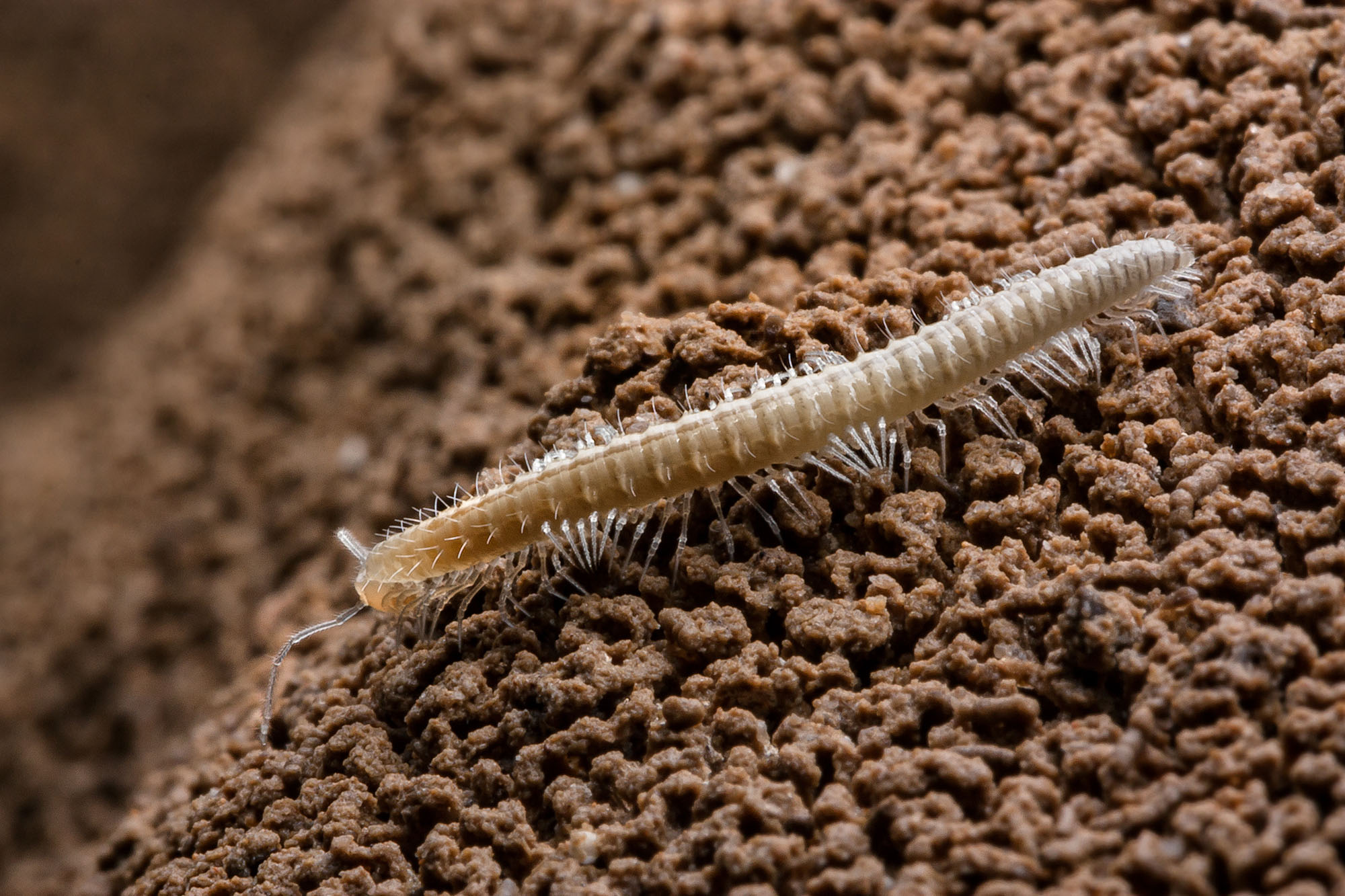
Myriapods
Centipedes (Chilopoda)
Centipedes (Latin Chilopoda) are animals that belong to the class of Myriapoda. Currently, there are about 3,150 known species distributed on almost all continents and habitats, from tropical rain forests and deserts to beyond the Arctic Circle. The limiting factor for the distribution of centipedes is humidity, and experiments carried out on some species show that they prefer habitats with 100% humidity.
The body of the centipedes consists of numerous body segments, up to 191 and each of them has a pair of legs. The animals have an elongated body, from 4 mm to 30 cm in length, with a head that is clearly distinct from the rest of the body. They have one pair of tentacles on their heads. Centipedes are predators and hunt using the jaw legs, the first pair of legs transformed into curved spines that contain poisonous glands. The poison is released into the jaws when the prey is bitten. They are mostly ground dwellers who avoid light and prefer moist microhabitats where they stay during the day, hiding under leaves and stones, while they come out to hunt at night.
Underground habitats such as caves belong to humid habitats, with a constant humidity level of usually 90-100%, and they are also characterized by a lack of light, which makes them an ideal habitat for centipedes. Many species are often found in caves and their entrances, where they can create populations or use them as convenient shelters. Adaptations to subterranean habitats in centipedes are visible as lengthening of tentacles and legs, and a reduction in the number of ocellus (organs for vision) and pigment. So far, troglobiont species of centipedes have been recorded mainly in Europe, Central America and Australia. In underground habitats, centipedes are found at the top of the food web. They are predators that feed on everything that is smaller than them, and even on other predators such as spiders and pseudoscorpions. Cannibalism is also often recorded, and immature individuals can become prey to other invertebrates.
Ten troglobiont species have been recorded in Croatia, most of which belong to the order Lithobiomorpha. In The Red Book of Cave Fauna of Croatia, two troglobiont species of the genus Eupolybothrus, E. leostygis and E. obrovensis, are listed as endangered (EN) and sensitive (VU) species. Direct threats to their habitat include anthropogenic habitat change, urbanization, and pollution. While E. obrovensis lives in Istria and Slovenia, E. leostygis has been recorded in the vicinity of Dubrovnik and Herzegovina.
In 2015, a new troglobiont species from the order Geophilomorpha was described. Hades’ centiped, Geophilus hadesi, is only the second described troglobiont from this order. It was described from Munižaba cave on Crnopac, the massif of southeastern Velebit Mt. The species was also recorded in another deep pit on Crnopec at a depth of 500 m, and in the cave system Lukina jama – Trojama, where one specimen was collected at -980 m, and one observed at -1,100 m. This is the deepest record of a centipede in the world. The species is considered endemic to Velebi Mt.
CONTACT:
Ana Komerički – ana.komericki@hbsd.hr
BIBLIOGRAPHY:
- Lewis, J. G. E. (1981): The Biology of Centipedes. Cambridge University Press. pp. 488. https://doi.org/10.1017/CBO9780511565649
- Minelli (ed.) (2011): Treatise on Zoology – Anatomy, Taxonomy, Biology. The Myriapoda, Volume 1. Brill, Leiden, Boston. pp. 538.
Millipedes (Diplopoda)
With over 12 000 species, Millipedes (Diplopoda) are the largest class of myriapods (Myriapoda), a group which also includes centipedes and other multi-legged arthropods. This class includes millipede Illacme plenipes, the leggiest animal in the world – some specimens of this species have up to 750 legs. Most millipedes have very elongated bodies with numerous segments, and almost every segment carries two pair of legs.
They are mostly detritivores, feeding on decomposing plant and animal parts as well as feces. Millipedes thus have an important role in the decomposition of plant litter and in the cycling of nutrients in the soil. Their exoskeleton is incrusted with calcium carbonate, which also makes millipedes important for calcium circulation in the soil. The need for calcium results in a greater number of millipedes in karst areas of the world. Due to their lack of speed and in order to protect themselves from predators, millipedes emit various liquid secretions, which contain many irritant and toxic chemicals, such as phenols, benzoquinones, alkaloids and hydrogen cyanide; some of these substances have antibacterial and antifungal activity.
Croatian fauna includes about 180 species, of which some 30 are troglobionts, mostly endemic for Croatia or the Dinarides.
CONTACT:
Tvrtko Dražina – tdrazina@gmail.com
BIBLIOGRAPHY:
- Blower, G. J. (1985): Millipedes. The Linnean Society of London and The Estuarine and Brackish-Water Sciences Association. pp. 229.
- Marek, E. P., Shear, A. W. & Bond, J. E. (2012): A redescription of the leggiest animal, the millipede Illacme plenipes, with notes on its natural history and biogeography (Diplopoda, Siphonophorida, Siphonorhinidae). ZooKeys 241: 77-112.
- Mršić, N. (1994): The Diplopoda (Myriapoda) of Croatia. Dvojenoge (Diplopoda: Myriapoda) Hrvatske. Razprave IV. razreda SAZU 35: 219-296.





